Sanqing Mountain Scenic Area, a UNESCO World Natural Heritage site, World Geopark, National Natural Heritage site, and National AAAAA-level tourist attraction, boasts some of China's most breathtaking natural landscapes. The area is renowned for its dramatic peaks, towering mountains, and scattered rock pinnacles that resemble natural scroll paintings. Among its most stunning features are the Nanqingyuan Scenic Area, showcasing granite peak forests shaped over 1.4 billion years, and the West Coast Scenic Area, offering high-altitude trails with panoramic views of the sea of clouds and dramatic canyon scenery.
The Nanqingyuan Scenic Area showcases the characteristics of granite peak forest landscapes formed through 1.4 billion years of geological evolution, allowing visitors to appreciate the incredible handiwork of nature. On the other hand, the West Coast Scenic Area features scenic high-altitude trails, offering breathtaking views of the sea of clouds and canyon scenery that transport visitors to a seemingly enchanted realm.
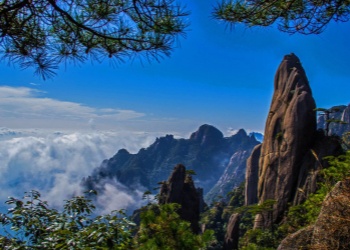
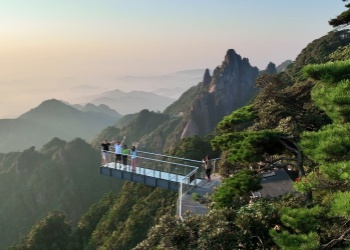
Moreover, the Sanqingshan Scenic Area is also a significant birthplace of Taoist culture. Numerous Taoist temples and palaces are scattered throughout the area, with the most renowned being the Sanqing Palace. The Sanqing Palace complex is built according to the principles of the Eight Trigrams layout, exhibiting an elegant and ancient charm that embodies the unique allure of Taoist culture. Here, visitors can delve deeper into the historical origins and cultural connotations of Taoism.
Main Attractions in Sanqingshan
Yixiantian
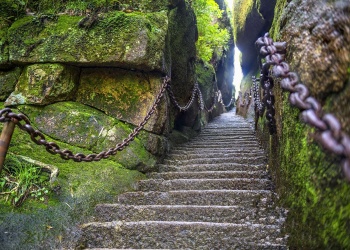 The Yixiantian
The Yixiantian
The staircase of Yixiantian consists of 299 steps, which is homophonous with "ai jiu jiu" in Chinese, signifying enduring love. Along both sides, there are five platforms named Xiangsi (Mutual Longing), Xiangzhi (Mutual Understanding), Xianglian (Falling in Love), Xiangai (Loving Each Other), and Tongxin (Sharing the Same Heart), symbolizing the elevation of the theme of love. Additionally, there are nine small steps, representing the everlasting nature of love and the fulfillment of lovers' dreams. When visitors ascend to the Jiujiu Platform, they can almost feel the happiness and fulfillment of love. The landscape of Yixiantian has undergone long-term evolution and shaping in geological history. Sanqingshan has experienced numerous tectonic movements and erosion processes during its geological past, resulting in the unique peak-forest landform it presently displays. This geomorphological feature is fully demonstrated in Yixiantian, presenting visitors with a stunning display of nature's wonders.
Yunv Kaihuai
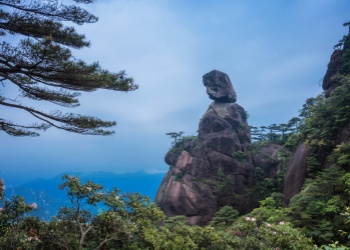 The Yunv Kaihuai
The Yunv Kaihuai
The landscape of Yunu Kaihuai is uniquely shaped and vividly portrayed. On a natural stone platform, a pair of round and holy breasts are revealed amidst the green pines and trees. On top of the breasts, two delicate and rounded jade pearls stand gracefully, resembling twin lotus flowers emerging from the water. The breasts and pearls are naturally formed, seamlessly integrated, and a masterpiece of nature's creation, leaving people in awe. Moreover, Yunu Kaihuai carries profound cultural connotations. It is a symbol of Sanqingshan's utmost purity and beauty, where the hard stone peaks exhibit a plump and graceful form, demonstrating the wonders of nature's creation. In folk legends, Yunu Kaihuai is closely linked to the miraculous story of the birth of Laozi, the founder of Taoism. These legends add more mystery and cultural depth to Yunu Kaihuai.
Azalea Valley
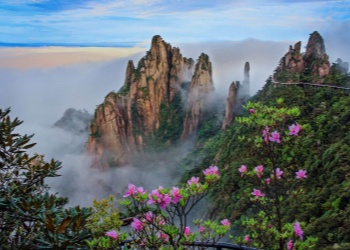 The Azalea Valley
The Azalea Valley
Sanqingshan Azalea Valley, located within the Nanqingyuan Scenic Area, is a must-visit destination that attracts large numbers of tourists every April, May, and June. Here, vast tracts of alpine azaleas bloom in a riot of colors during the warm spring season, creating a sea of flowers. A particular highlight is that most of the azalea trees here are over a thousand years old and reach several meters in height, making the scenery especially spectacular when they bloom in clusters. The Azalea Valley boasts a diverse array of azalea species, including more than ten varieties such as Houtou azaleas, Yunjin azaleas, and Lujiao azaleas. There are two unique characteristics of the azaleas here. Firstly, they have a "ten-month gestation period," meaning that they bloom in May each year, form new buds after their flowers fade in July or August, and bloom again the following May. This entire reproductive process lasts for up to ten months. Secondly, the azaleas undergo a color change, starting as red when they first bloom, gradually turning pink, then purple, and finally white. This color transformation adds considerable charm to the Azalea Valley.
The West Coast
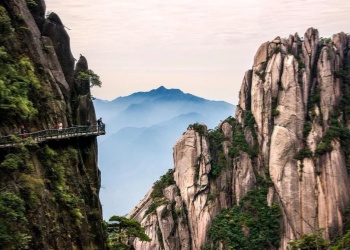 The West Coast
The West Coast
The West Coast of Sanqingshan, also known as the West Sea Trail, is located in the western part of Sanqingshan Mountain. This trail, situated on a cliff overlooking a precipice at an altitude of approximately 1,600 meters, protrudes outward, forming a reinforced concrete trail with a total length of about 3,700 meters and a width ranging from 1.3 meters to 2 meters. A 2,700-meter-long section of the trail has no steps and is as flat as a shore, resembling a jade belt wrapped around the mountains, hence the name "West Coast." The West Coast scenic area is one of the most thrilling and scenic areas of Sanqingshan Mountain, connecting the northern and southern mountainous regions of the mountain and forming a spectacular Golden Coast. Walking on the West Coast Trail, tourists can appreciate the unique natural scenery of Sanqingshan Mountain.
Sanqing Palace
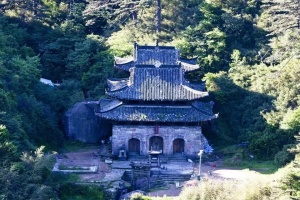 The Sanqing Palace
The Sanqing Palace
The Sanqing Palace, located at an altitude of 1,533 meters, is a landmark building of Taoism in Sanqingshan Mountain. The Sanqingfu Land is a gathering place for the cultural landscapes of Sanqingshan Mountain and also an “open-air museum” of ancient Taoist architectural complexes. The Sanqing Palace has a long history. According to legend, during the Eastern Jin Dynasty, Ge Hong and Li Shangshu “built huts to refine elixirs” and practiced Taoism. Since then, the history of Taoism in Sanqingshan Mountain has been passed down for more than 1,600 years. The Sanqing Palace gradually took shape during the construction and expansion of the Tang, Song, Yuan, Ming, and Qing dynasties. The current structure of the Three Purities Palace dates back to the Ming Dynasty. Despite enduring various challenges over time, it has retained the style and characteristics of ancient architecture.
Two ropeways up the mountain
Sanqingshan Mountain boasts two cable cars: the South Cable Car and the Jinsha Cable Car.
The South Cable Car, also known as the Waishuangxi Cable Car, is located in an area with complete tourism facilities and various hotel options to cater to different tourists' needs. It takes approximately 8 minutes to ride the cable car, and each gondola can accommodate 8 people. During the ride, tourists can enjoy one of the most breathtaking scenes of Sanqingshan Mountain, known as "Guanyin Appreciating Music." After reaching the upper station of the cable car, one will arrive at Nantianmen. From here, tourists can choose to visit scenic spots such as the West Coast, the Three Purities Palace, and the East Coast, or travel south to explore the Yixian Tian and Yunu Kaihuai areas of Nanqingyuan. However, it's worth noting that after taking the South Cable Car, tourists may need to climb quite a few steps, which takes approximately two to two and a half hours to reach some attractions of Sanqingshan Mountain, such as Sichuan Goddess and the Emerging Giant Python.
The Jinsha Cable Car, also known as the East Cable Car, is situated in Jinsha, the eastern part of Sanqingshan Mountain. Despite its total length of 2,670 meters, the ride only takes 10 minutes, and each gondola can also accommodate 8 people. One significant advantage of the Jinsha Cable Car is its high speed, which saves time for tourists. Additionally, the lower station of the cable car is located in Jinsha, the largest tourism service reception area of Sanqingshan Mountain, while the upper station is only a 30-minute walk from the core attraction of the mountain, "the Eastern Goddess," making it more convenient for tourists to access the main attractions. The Jinsha Cable Car is the first "5S" cable car in Jiangxi Province.



































